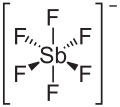Hexafluoroantimonic acid
| Structural formula | |||||||||||||||||||
|---|---|---|---|---|---|---|---|---|---|---|---|---|---|---|---|---|---|---|---|
 |
|||||||||||||||||||
| General | |||||||||||||||||||
| Surname | Hexafluoroantimonic acid | ||||||||||||||||||
| other names |
|
||||||||||||||||||
| Molecular formula | H [SbF 6 ] | ||||||||||||||||||
| Brief description |
colorless liquid |
||||||||||||||||||
| External identifiers / databases | |||||||||||||||||||
|
|||||||||||||||||||
| properties | |||||||||||||||||||
| Molar mass | 236.8 g mol −1 | ||||||||||||||||||
| Physical state |
liquid |
||||||||||||||||||
| density |
2.89 g cm −3 |
||||||||||||||||||
| Vapor pressure |
19 h Pa (18 ° C) |
||||||||||||||||||
| safety instructions | |||||||||||||||||||
|
|||||||||||||||||||
| As far as possible and customary, SI units are used. Unless otherwise noted, the data given apply to standard conditions . | |||||||||||||||||||
Hexafluoroantimonic acid , which is counted among the super acids , is one of the strongest acids known . It is a mixture of the very strong Lewis acid antimony (V) fluoride and the medium-strength Brønsted acid hydrogen fluoride in different proportions. Since the acid strength can no longer be measured directly, it is determined using Hammett's acidity function. A mixture in which SbF 5 and HF are present in a ratio of 1,200 has an H 0 value of about −21. With larger amounts of SbF 5 , the H 0 value decreases further down to the minimum value of −31.3, which is present at a mixing ratio of 1∶1. (Pure sulfuric acid has an H 0 value of −11.9, making it several trillion times less acidic .)
Due to its strength, hexafluoroantimonic acid, like the similar magic acid , can protonate many substances, especially hydrocarbons . This breaks them down into smaller molecules and is then soluble in many organic solvents.

- Reaction of hydrogen fluoride and antimony (V) fluoride to form fluoroantimonic acid
Individual evidence
- ↑ a b c d e Fluoroantimonic acid data sheet from Sigma-Aldrich , accessed on April 1, 2011 ( PDF ).
- ^ E. Riedel: Moderne Anorganische Chemie, de Gruyter, Berlin, 1999 .


